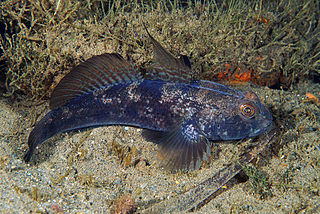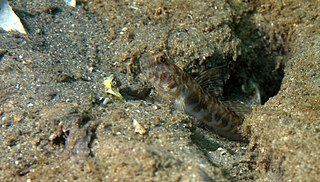
Gobiidae or gobies is a family of bony fish in the order Gobiiformes, one of the largest fish families comprising more than 2,000 species in more than 200 genera. Most of gobiid fish are relatively small, typically less than 10 cm (3.9 in) in length, and the family includes some of the smallest vertebrates in the world, such as Trimmatom nanus and Pandaka pygmaea, Trimmatom nanus are under 1 cm long when fully grown, then Pandaka pygmaea standard length are 9 mm (0.35 in), maximum known standard length are 11 mm (0.43 in). Some large gobies can reach over 30 cm (0.98 ft) in length, but that is exceptional. Generally, they are benthic or bottom-dwellers. Although few are important as food fish for humans, they are of great significance as prey species for other commercially important fish such as cod, haddock, sea bass and flatfish. Several gobiids are also of interest as aquarium fish, such as the dartfish of the genus Ptereleotris. Phylogenetic relationships of gobiids have been studied using molecular data.

Mudskippers are any of the 23 extant species of amphibious fish from the subfamily Oxudercinae of the goby family Oxudercidae. They are known for their unusual body shapes, preferences for semiaquatic habitats, limited terrestrial locomotion and jumping, and the ability to survive prolonged periods of time both in and out of water.

Lake Towuti is a lake in East Luwu Regency, South Sulawesi province, Indonesia. Surrounded by mountains, it is the largest lake of the island of Sulawesi and one of the five lakes of the Malili Lake system. A river flows from the lake to the Boni Bay. The town Laronda is located on its shore.

The black goby is a species of ray-finned fish found in the Eastern Atlantic and Mediterranean Sea and Black Sea. It inhabits estuaries, lagoons, and inshore water over seagrass and algae. It feeds on a variety of invertebrates and sometimes small fish. This species can also be found in the aquarium trade.
The Hawaiian freshwater goby, or ‘O‘opu, is a species of goby endemic to Hawaii, where it occurs in mountain streams. Males of this species can reach a standard length of 7 cm (2.8 in), while females only reach 6 cm (2.4 in).

Elacatinus oceanops, commonly known as the neon goby, is a species of goby native to waters of the Atlantic and Gulf coast of North America from Florida to Belize. This cleaner fish can be found on coral heads at depths from 1 to 45 m. This species grows to a total length of 5 cm (2.0 in). This species can also be found in the aquarium trade.

The Gobiiformes are an order of fish that includes the gobies and their relatives. The order, which was previously considered a suborder of Perciformes, is made up of about 2,211 species that are divided between seven families. Phylogenetic relationships of the Gobiiformes have been elucidated using molecular data. Gobiiforms are primarily small species that live in marine water, but roughly 10% of these species inhabit fresh water. This order is composed chiefly of benthic or burrowing species; like many other benthic fishes, most gobiiforms do not have a gas bladder or any other means of controlling their buoyancy in water, so they must spend most of their time on or near the bottom. Gobiiformes means "goby-like".

The rock goby is a small coastal goby of eastern Atlantic waters, from Scotland to Senegal. It is also reported from the Mediterranean and Black Seas, and is an anti-Lessepsian migrant in the Gulf of Eilat and Red Sea. There are unconfirmed records from the area around Pointe Noire in Congo-Brazzaville.

Coryphopterus glaucofraenum, the bridled goby, is a species of goby native to the Western Atlantic Ocean and the Caribbean Sea from North Carolina to Brazil. It can be found on reefs at depths of from 2 to 45 metres in areas of white sand. This species can reach a length of 8 centimetres (3.1 in) TL. It occasionally makes its way into the aquarium trade.

Elacatinus evelynae, the sharknose goby, Caribbean cleaner goby, Caribbean cleaning goby, is a species of goby native to the Western Atlantic Ocean from the Bahamas and the Lesser Antilles to the northern coast of South America, as well as the Antilles and western Caribbean.
Elacatinus horsti, the yellowline goby, is a species of goby native to the western Atlantic Ocean and the Caribbean Sea.
Elacatinus chancei, the shortstripe goby, is a species of ray-finned fish in the family Gobiidae. It lives inside or on the surface of a sponge and occurs in tropical waters in the west central Atlantic Ocean, the Bahamas, the Antilles, and Venezuela.
Ginsburgellus novemlineatus, the Nineline goby, is a species of goby native to tropical reefs of the western Atlantic Ocean and the Caribbean Sea. It is frequently found associated with the sea urchin Echinometra lucunter, living underneath the urchin. This species grows to a length of 2.5 centimetres (0.98 in) TL. This species can also be found in the aquarium trade. This species is the only known member of its genus, the name of which honours the ichthyologist Isaac Ginsburg (1886-1975) of the U.S. National Museum who had an interest in gobies.

The wolfsnout goby, also known as the dognsout goby or cup-sponge goby, is a species of goby native to the Indian Ocean and the western Pacific Ocean. This species lives on large fan-shaped or floppy sponges, particularly Phyllospongia foliascens and Phyllospongia papyracea, growing on reefs at depths down to 15 metres (49 ft). This species grows to a length of 3.5 centimetres (1.4 in) SL. This species is the only known member of its genus. It spans benthically and is a solitary species.

The orangespotted goby is a species of goby native to the tropical Atlantic coast from Bermuda and southern Florida through the Caribbean Sea and Gulf of Mexico south to the Caribbean coasts of Venezuela and Colombia, where it prefers silty bottoms around reefs. It is a commensal with an alpheid shrimp. This species grows to a length of 10 centimetres (3.9 in) TL. This species is the only known member of its genus.

Pleurosicya is a genus of gobies native to reef environments of the Indian Ocean and the western Pacific Ocean.
Robinsichthys arrowsmithensis is a species of goby found on the Arrowsmith Bank in the Caribbean Sea at depths of from 92 to 596 metres. This species grows to a length of 2.3 centimetres (0.91 in) SL. This species is the only known member of its genus. The name of this genus honours C. Richard Robins (1928-2020), an American ichthyologist who was an important contributor to the study of gobies of the Americas.
Elacatinus colini, the Belize sponge goby, is a species of goby native to the Western Central Atlantic Ocean, near Belize and Honduras.

Pleurosicya mossambica, also known as the toothy goby or the Mozambique ghost goby, is a small species of goby native to the tropical Indo-West Pacific region. It was first described by South African ichthyologist J.L.B. Smith in 1959. Like many other gobies, it forms commensal relationships with several other marine invertebrates, including soft corals and sponges.
Evermannichthys bicolor is a perciform species of fish in the family Gobiidae. As their name suggests, fishes in this species live inside sponges and can be found in the Caribbean Sea. The size of their populations are unknown, meaning it is not currently clear whether the bicolored sponge goby is in need of conservation.












